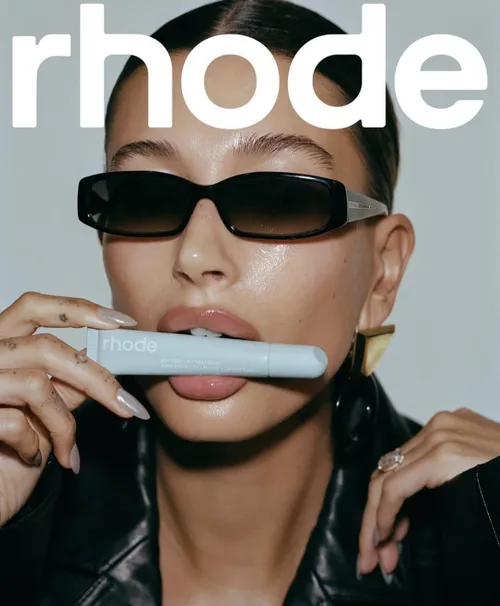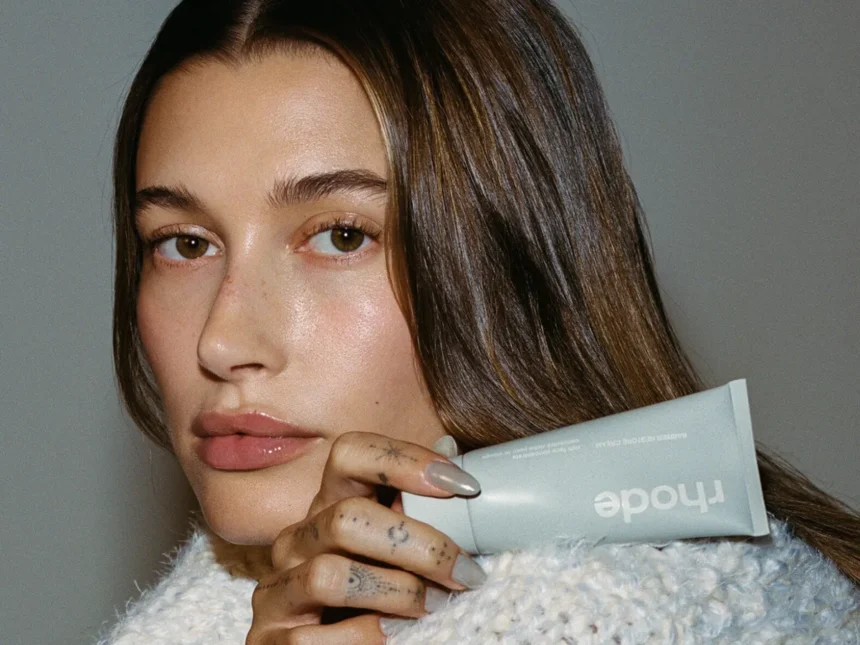When Hailey Bieber announced the launch of her skincare brand Rhode in 2022, few could have predicted what was coming. The celebrity beauty market already felt overcrowded, and many assumed Rhode would be another short-lived vanity project. But in less than three years, Bieber proved every skeptic wrong. Rhode is now a billion-dollar business, a cultural phenomenon, and perhaps the most surprising success story in beauty’s recent history. What makes Rhode different? The answer lies in the simplicity of its products, the timing of its arrival, and the way Bieber turned her personal aesthetic into a global movement.
From the very beginning, Rhode refused to play by the traditional rules of celebrity beauty launches. Where others debuted with massive product lines and flashy advertising campaigns, Bieber kept her vision stripped back. She released just three products: the Peptide Glazing Fluid, the Barrier Restore Cream, and the Peptide Lip Treatment. It was an audaciously minimal approach at a time when beauty shelves were overflowing with options, but it worked because it reflected her own philosophy of skincare. Bieber wasn’t trying to overwhelm consumers. She wanted to deliver essentials they could trust, a routine rooted in hydration, barrier care, and a glow that looked healthy rather than artificial.
The branding sealed the deal. Bieber coined the phrase “glazed donut skin,” describing the ultra-dewy, luminous finish that became Rhode’s signature. The phrase was cheeky, memorable, and instantly viral. TikTok creators latched onto it, producing millions of videos as they tried to achieve the same sheen. The aesthetic quickly spilled beyond skincare. Manicures, hairstyles, and even fashion collections were labeled “glazed donut inspired.” In an era where virality often determines consumer behavior, Bieber had unintentionally created a cultural shorthand that carried Rhode far beyond the shelves of Sephora.
Part of Rhode’s success comes from its accessibility. Bieber and her team were deliberate about pricing, positioning the brand in the sweet spot between drugstore affordability and luxury prestige. Most products retailed between $16 and $30, a price point that allowed younger consumers to indulge while still feeling like they were buying into something aspirational. This democratization of high-quality skincare gave Rhode an edge over competitors whose products often came with hefty price tags. It wasn’t luxury for the elite; it was luxury for the everyday shopper.

But perhaps the most important factor in Rhode’s rise is authenticity. Bieber has always been open about her skincare struggles, from sensitivity to breakouts, and she infused those experiences into the DNA of the brand. She frequently appeared on social media barefaced, applying her own products, sharing her personal routines, and speaking candidly about the realities of running a business. The transparency built credibility in a market where consumers are quick to spot inauthenticity. Rhode didn’t feel like a marketing stunt. It felt like an honest extension of Hailey Bieber herself.
Scarcity also played a role in fueling demand. Rhode borrowed tactics from streetwear culture, releasing products in limited drops that sold out within hours. Waitlists ballooned into the hundreds of thousands. Restocks became events in themselves. This scarcity created buzz while building loyalty among customers who proudly referred to themselves as “Rhode girls.” Yet Bieber was careful not to push exclusivity too far. Restocks always arrived quickly enough to keep fans engaged rather than frustrated. It was a delicate balance of desire and access, and it worked brilliantly.
As Rhode grew, its expansion remained thoughtful rather than rushed. The Lip Treatment line, which began as a single unscented product, evolved into a collectible series with flavors like passionfruit and salted caramel. Each new launch was teased with stylish campaigns that felt editorial yet attainable. By 2024, tinted versions were introduced, blurring the line between skincare and makeup and hinting at Rhode’s long-term potential as a cross-category beauty powerhouse.
The social media strategy behind Rhode has been a masterclass in modern marketing. Bieber’s personal Instagram often doubles as Rhode’s campaign feed, blending her lifestyle content seamlessly with brand imagery. TikTok amplified the brand even further as users documented their first impressions, routines, and comparisons. Even celebrities outside Bieber’s circle were seen carrying Rhode lip products, giving the brand an aura of effortless cool. Crucially, Rhode leaned heavily into reposting user-generated content, turning everyday fans into unofficial ambassadors. This grassroots marketing loop created a sense of community while reducing the need for traditional advertising.
By 2025, Rhode had officially crossed the billion-dollar threshold, earning unicorn status in the beauty industry. Its valuation was driven by consistent sell-outs, strategic international expansion into Europe and Asia, and partnerships with major retailers. Repeat purchase rates were remarkably strong, a testament to the effectiveness of the formulas. Unlike many celebrity brands that burn brightly and then fade, Rhode proved it had staying power.
What’s perhaps most fascinating about Rhode’s rise is how it extended beyond the beauty aisle. “Glazed donut” became more than a skincare term—it evolved into an entire aesthetic, one that represented minimalism, health, and a kind of quiet luxury. Pinterest boards, nail salons, and runway trends echoed Rhode’s glossy influence. And through it all, Bieber herself became the embodiment of this new lifestyle, shifting from model and celebrity wife to respected entrepreneur with a billion-dollar company under her belt.
The lessons from Rhode’s success are clear. Start small, rather than overwhelming consumers with dozens of products. Own a signature aesthetic that can translate into culture. Price strategically so the brand feels accessible yet aspirational. Above all, lead with authenticity. Bieber’s transparency about her skin and her business made Rhode feel relatable and trustworthy. The drop model kept fans engaged, while the brand’s clean design and consistent messaging built instant recognition.
Looking ahead, insiders predict Rhode will continue expanding carefully into makeup and body care. A tinted moisturizer seems like a natural next step, as does a body cream or fragrance that extends the brand’s identity. Whatever comes next, Bieber has proven she is more than just another celebrity name on a label. She has built one of the most culturally relevant beauty brands of the decade, and she has done it by trusting her instincts, respecting her community, and embracing the power of simplicity.
Rhode’s story is more than a tale of glowing skin—it’s about business acumen, timing, and cultural resonance. In just a few short years, Hailey Bieber has turned skepticism into admiration and transformed a modest skincare launch into a billion-dollar empire. The glazed donut glow may have started as a catchy phrase, but it has since become a symbol of modern beauty itself. And if Rhode’s trajectory is any indication, this is only the beginning of its story.








